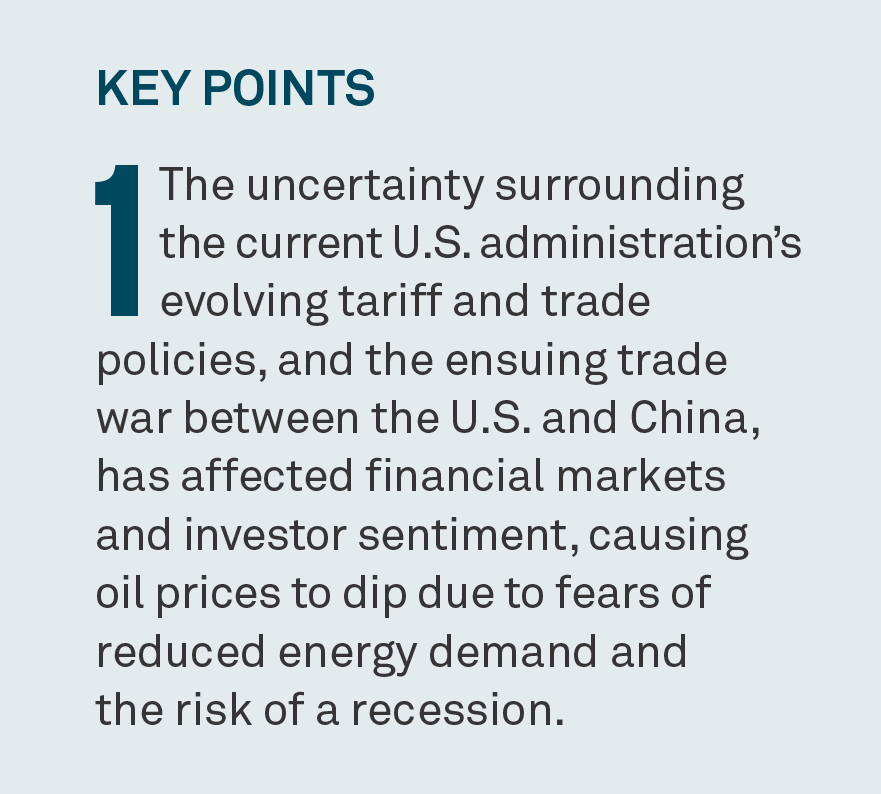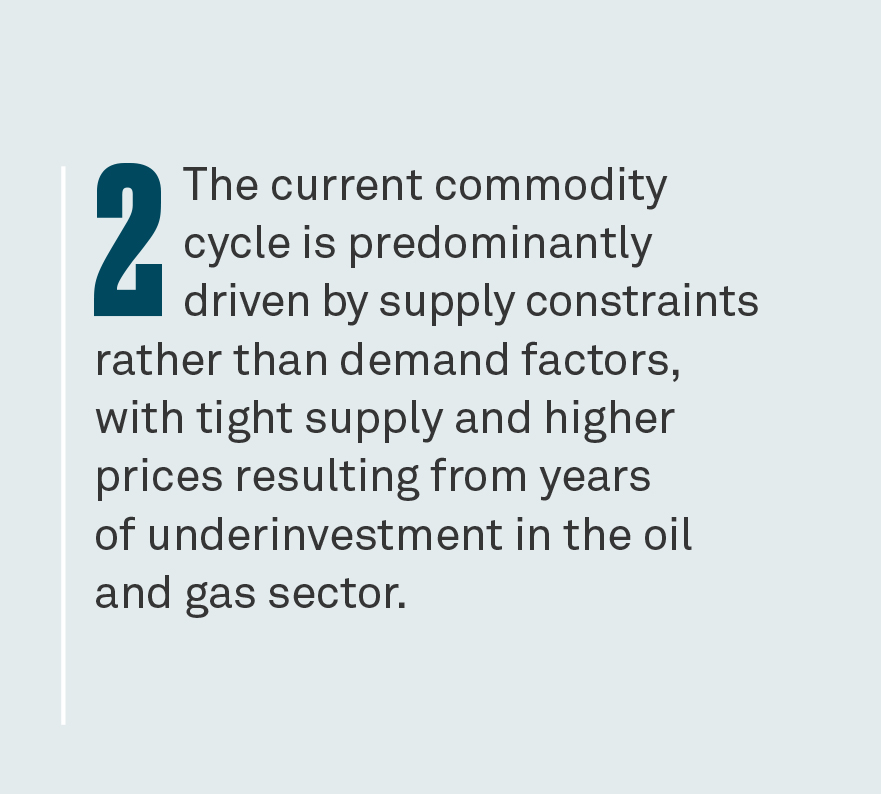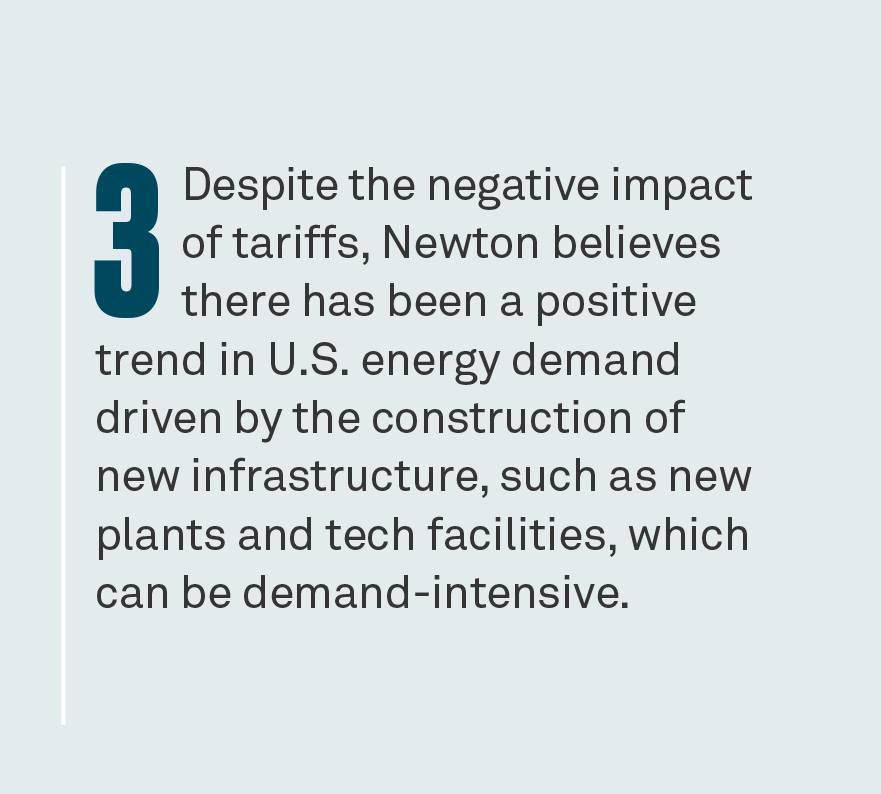June 2025
INVESTMENT VIEWS
FROM OUR PARTNERS AT NEWTON
INVESTMENT MANAGEMENT
Newton Global Natural Resources Team
Supply constraints and infrastructure growth drive a positive outlook for U.S. energy and commodities.



The uncertainty surrounding the current U.S. administration’s evolving tariff and trade policies, and the ensuing trade war between the U.S. and China, has rippled through financial markets, weighing on investor sentiment and fueling concerns over the direction of the global economy. While the White House generally excluded energy commodities from the extensive new import tariffs announced on April 2 — and largely paused a week later — energy markets were not immune from their impacts. Fears of reduced energy demand and the risk of a recession have caused oil prices to dip over the last few weeks. In addition, the evolving nature of U.S. tariff policies have prompted energy executives to withhold spending, further dragging on demand.
Despite the recent underperformance, Newton’s outlook on the oil and gas industry remains constructive. While sentiment has been weak, there has been no meaningful impact on demand at this point, according to industry data. We believe the supply-driven characteristics of the current commodity cycle, coupled with the U.S. administration’s pro-growth stance, suggest that commodities are likely to see higher prices in the coming years.
Supply-driven commodity cycle
Actions by the current U.S. administration may sway commodity prices in the short term, with potential for both positive and negative effects; however, their overall impact on the long-term trajectory of the commodity cycle is likely to be minimal, in our view.
The commodities market tends to operate in cycles that typically span 10 to 12 years. Most recently, we ended a down cycle and began an up cycle in 2020, following the initial impact of the Covid-19 pandemic.
We are currently in year five of a cycle that has been predominantly driven by supply-versus-demand factors. Unlike the early 2000s, when economic expansion in China caused commodity demand to surge, this cycle has been a product of supply constraints. Following years of underinvestment, the lack of capital expenditure (CapEx) in the oil and gas sector has led to tight supply and higher prices. As companies continue to hold the line on CapEx in the wake of U.S. tariffs, we expect this trend to continue.
Infrastructure and demand growth potential
Despite the negative impact of tariffs, there has been a positive trend in U.S. energy demand, driven by the construction of new infrastructure. We see companies building new plants, tech facilities and production capabilities, which all can be demandintensive. For instance, a multinational automotive giant just opened a new manufacturing facility for electric and hybrid vehicles in Georgia, representing the greatest single investment in the state’s history. Large-scale infrastructure developments such as this could lead to increased demand for commodities.
Despite the negative impact of tariffs, there has been a positive trend in U.S. energy demand, driven by the construction of new infrastructure.
Natural gas and electricity demand
U.S. electricity demand grew in 2024 for the first time in two decades,* while the era of energy efficiency improvements — installing smart thermostats and switching to LED light bulbs — appears to be waning. We are now witnessing a return to a gross domestic productlinked electricity growth profile. Additionally, the rise of artificial intelligence (AI) has substantially boosted global electricity requirements.
In our opinion, natural gas has emerged as a key component in meeting this growing appetite for electricity in the short term. The natural-gas industry, particularly in the U.S., has seen an upsurge in consolidation in recent years, as companies aim to increase operational efficiencies, gain access to resources and reduce costs. The rise in merger-and-acquisition activity has led to an overall reduction in production and capacity, with more assets in the hands of large public companies that appear to be prioritizing financial performance and shareholder value over growth. By increasing capital discipline, and thereby by limiting investments in new projects, these companies may constrain overall supply.
Additionally, liquefied natural gas export capacity is expected to double over the next five years. The increase in outlets for supply is likely to put upward pressure on domestic natural-gas prices. Following a winter of frigid temperatures across much of the U.S., inventories are currently below five-year averages.**
Commodities vs. stocks
Commodities, as represented by the S&P GSCI, have recently broken a multi-year downtrend versus stocks, as represented by the S&P 500.1 Newton believes that commodities have the potential to provide a compelling source of alpha and return generation. They may also offer risk mitigation during market downturns, as we saw during the selloff in early April.
Oil equities are currently offering free cash flow yields of 12–15% at a $70 per barrel oil price,2 which is considered the floor price for oil, in our view. If the $70 floor is accurate, as oil prices rise, these stocks are likely to become less expensive. Furthermore, it appears that company fundamentals have improved; many companies are now better managed and focused on return on capital, which may add to their potential upside. Additionally, relative to past oil sell-offs, we believe that the recent decline in oil equities is overdone.
The current U.S. administration’s pro-U.S. growth agenda could lift demand for commodities, as could any fiscal stimulus that European and Chinese governments implement in response.
Key drivers of the commodities market
The commodities market is a dynamic and often unpredictable space, influenced by myriad factors ranging from geopolitical events to technological advancements. The current U.S. administration’s pro-U.S. growth agenda could lift demand for commodities, as could any fiscal stimulus that European and Chinese governments implement in response. Conversely, U.S. tariffs and the ongoing trade conflict with China could drag on commodity demand.
While the uncertainty surrounding the U.S. administration’s evolving policies has affected financial markets and investor sentiment, Newton believes the long-term trajectory of the commodity cycle remains largely unaffected. The market has been structurally undersupplied for years due to a lack of funding for new production, growth projects and infrastructure. In addition, the construction of new infrastructure and the rise of AI have driven positive trends in U.S. energy demand, particularly for natural gas and electricity. Newton believes these conditions are likely to support attractive commodity prices through 2025.
About Newton
Newton is the active equity investment firm within BNY Investments.
1 Source: Bloomberg, April 29, 2025.
2 Source: Newton, March 27, 2025.
* Source: U.S. Energy Information Administration, “After more than a decade of little change, U.S. electricity consumption is rising again,” 5/13/25.
** Source: U.S. Energy Information Administration, Weekly Natural Gas Storage Report, 5/23/25.
IMPORTANT INFORMATION
Equities are subject to market, market sector, market liquidity, issuer, and investment style risks, to varying degrees. Investing in foreign denominated and/or domiciled securities involves special risks, including changes in currency exchange rates, political, economic, and social instability, limited company information, differing auditing and legal standards, and less market liquidity. These risks generally are greater with emerging market countries. Commodities contain heightened risk including market, political, regulatory, and natural conditions, and may not be suitable for all investors. The natural resources sector can be affected by events occurring in nature, inflation, and domestic and international politics. Interest rates, commodity prices, economic, tax, and energy developments, and government regulations may affect the natural resources sector and the share prices of the companies in the sector.
The S&P 500® Index is widely regarded as the best single gauge of large-cap U.S. equities. The index includes 500 leading companies and captures approximately 80% coverage of available market capitalization. The S&P GSCI (Standard & Poor’s Goldman Sachs Commodity Index) is one of the most widely recognized benchmarks that is broad-based and production weighted to represent the global commodity market beta. The index is designed to be investable by including the most liquid commodity futures. Investors cannot invest directly in any index.
Capital expenditures (CapEx) are funds used by a company to acquire, upgrade, and maintain physical assets such as property, plants, buildings, technology, or equipment.
Asset allocation and diversification cannot ensure a profit or protect against loss.
All investments involve risk, including the possible loss of principal. Certain investments involve greater or unique risks that should be considered along with the objectives, fees, and expenses before investing.
This material has been provided for informational purposes only and should not be construed as investment advice or a recommendation of any particular investment product, strategy, investment manager or account arrangement, and should not serve as a primary basis for investment decisions.
PAST PERFORMANCE IS NOT NECESSARILY INDICATIVE OF FUTURE RESULTS. Any reference to a specific security, country or sector should not be construed as a recommendation to buy or sell this security, country or sector. Please note that strategy holdings and positioning are subject to change without notice.
This information has inherent limitations and is being provided with the benefit of hindsight. Prevailing market conditions may be materially different from historical market conditions and may produce materially different results from those shown here.
Material in this publication is for general information only. The opinions expressed in this document are those of Newton and should not be construed as investment advice or recommendations for any purchase or sale of any specific security or commodity. Certain information contained herein is based on outside sources believed to be reliable, but its accuracy is not guaranteed.
Issued by Newton Investment Management North America LLC (“NIMNA”) or the “Firm”). NIMNA is a registered investment adviser with the U.S. Securities and Exchange Commission (“SEC”) and subsidiary of The Bank of New York Mellon Corporation (“BNY”). The Firm was established in 2021, comprised of equity and multi-asset teams from an affiliate, Mellon Investments Corporation. The Firm is part of the group of affiliated companies that individually or collectively provide investment advisory services under the brand “Newton” or “Newton Investment Management.” Newton currently includes NIMNA and Newton Investment Management Ltd (“NIM”) and Newton Investment Management Japan Limited (“NIMJ”).
Statements are current as of the date of the material only. Any forward-looking statements speak only as of the date they are made, and are subject to numerous assumptions, risks, and uncertainties, which change over time. Actual results could differ materially from those anticipated in forward-looking statements. No investment strategy or risk management technique can guarantee returns or eliminate risk in any market environment and past performance is no indication of future performance.
BNY Investments is one of the world’s leading investment management organizations, encompassing BNY’s affiliated investment management firms and global distribution companies. BNY is the corporate brand of The Bank of New York Mellon Corporation and may be used to reference the corporation as a whole and/or its various subsidiaries generally.
© 2025 BNY Mellon Securities Corporation, distributor, 240 Greenwich Street, 9th Floor, New York, NY 10286.
MARK-744490-2025-05-22